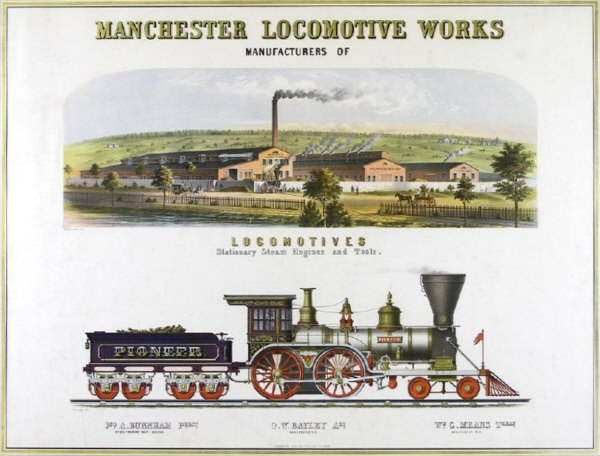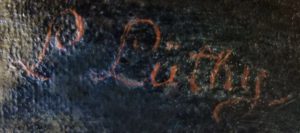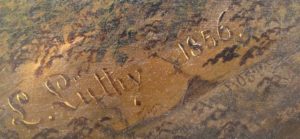Lüthÿ was active in America during the period 1841 to 1864.
All that is currently known about Lorenzo Lüthÿ has been gleaned from analyzing the subjects, canvas stamps, and inscriptions on his fourteen known paintings (five of which are in museum collections) and prints (view of the Manchester Locomotive Works in the collection of the New Hampshire Historical Society) as well as genealogy and ship passenger records. Many of his paintings are of similar size, 26″ to 29″ high and 36″ wide. His paintings are very detailed and linear in style consistent with his ability as a calligrapher and print maker. He painted duplicates of at least two of his subjects. He painted six known versions of Mt. Washington from North Conway.
We know that he was a Captain because one of his paintings is signed “Capt:n L. Lüthÿ”. Research has revealed that Lüthÿ was also described as a Professor. Except for his views of Mount Washington with the town of North Conway in the foreground, many of his paintings were portraits of buildings, probably done on commission for the owners. The building portraits were of fancy homes or mansions and based on where some of these paintings are currently found, it appears that he socialized with wealthy art patrons. His wife was from Prussian royalty.
Lüthÿ was born in Switzerland around 1811 based on ship records from 1841 listing him as a 30-year-old artist. He traveled to South America and then on to the United States through Philadelphia in 1841, apparently to have a work of his published as a lithograph. He was in Central America by 1850 when he returned to America via New Orleans.
In 1854 he was in Hoboken, New Jersey where he painted a large colonial house on a hill called Sip Homestead at Hoboken New Jersey. This painting was acquired by Maxim Karolik and subsequently given to the Shelburne Museum in Vermont where it still resides. It is signed “Capt:n L. Lüthÿ Fecit. / Hoboken. 1854-“.
In 1854 he painted Murray Hill Fifth Avenue, New York, the elaborate home of William Coventry H. Waddell. He signed the painting “L. Luthy / 91 Bowery 1854”. William Coventry H. Waddell was a financial agent for the United States Department of State, US Marshall for the southern district of New York, and Registrar of Bankruptcy. He and his wife were New York socialites and had many parties. They had a second floor art gallery at their lavish Murray Hill mansion.
Lüthÿ was in Boston sometime between 1853 and 1856 and purchased canvas from artist supplier N. D. Cotton. A painting of Mount Washington from North Conway Village, NH bears the canvas stamp “ENGLISH PREPARED CANVAS / FROM / N. D. Cotton / 7 Tremont St / BOSTON.” The dates above can be established by the fact that N. D. Cotton was only at that particular address between 1853 and 1856.
In 1855 he painted two almost identical portraits of the Amoskeag Woolen Mills in Manchester, New Hampshire from the west bank of the Merrimack River. These mills were owned by the Boston Associates, and the paintings were in the possession of the Amoskeag Manufacturing Company (Manchester, NH, and Boston, MA), until the 20th century. Sometime during the 20th century, they were acquired by the Manchester Historic Association where they are in their collection today. His son George was also born that same year in Manchester, NH.
He painted six almost identical pictures of Mount Washington and the village of North Conway, most likely between 1854 and 1856. One has a stamp on the back “Thompson Collection / New York –1870. / Geo. P. Rowell.” It was owned by Thomas Thompson of Boston in the 1860s and was sold by Leeds and Miner of NYC as lot #54 in the 1870 auction of the Thompson Collection. It was purchased at that sale by Henry C. Lewis. In 1895, the painting was bequeathed by Lewis to the University of Michigan Museum of Art. Another version is in a private collection and is signed but undated except for the N.D. Cotton canvas stamp which dates it between 1853 and 1856. A third version in a private collection is dated 1856 and inscribed “Boston”. A fourth undated version which is smaller than the other three is from the Robert L. Stuart Collection of the New York Public Library and is on permanent loan to the New York Historical Society.
In 1856 a pen drawing belonging to the artist was exhibited at the Boston Athenaeum as Lot #281 by “L. Luethy”. The subject and present location of the drawing are unknown.
He appeared to travel from Hoboken New Jersey in 1854, to New York City, then up the coast to Boston, to Manchester, New Hampshire, and eventually to North Conway, New Hampshire, the summer tourist grounds of the wealthy inhabitants of Boston. He was in Boston in 1856 and 1857 and in Washington D.C in the 1860s. His whereabouts after that are unknown, but his wife and sons ended up in Baltimore in the 1870s and in Philadelphia in the 1880s.
It is likely that there are other undiscovered works by Lüthÿ, and anyone with knowledge of other paintings is asked to please share their information with us. Please contact the authors.
Chronology
| c. 1811 | Born in Switzerland (date and place yet unknown) |
| c. 1840–60 | “distinguished himself in Europe by a series of . . . works, viz: “The Constitution of Switzerland,” “The Roman Republic of 1848,” the admirable “Panorama of Leghorn,” executed by the respective orders of the federal government of Switzerland, his Holiness the Pope, and the late Grand Duke of Tuscany.” |
| c. 1840 | his panoramic view of the port city of Livorno (also known as Leghorn) and surrounding landscape in Tuscany, Italy, as seen from a harbor lighthouse, was lithographed in three sections by August Podesta (1813–58) |
| 1841, June 28 | “Lorenzo Luthy” advertised as a professional calligrapher in the Caracas newspaper El Venezolano, taking subscriptions for a lithograph to be made under his direction in the United States and celebrating the 1811 Venezuelan declaration of independence |
| 1841, Aug. 24 | “Lorenz Luthy,” described as a 30-year-old artist from Switzerland sailed aboard the Brig Caracas from La Guaira, Venezuela, to Philadelphia (apparently to arrange for the lithography and intending to return to Caracas and live—or continue to live–there)—described in Aug. 26 Philadephia arrival notice as “Mr. Lawrence Luthy of Carracas” |
| 1850, Dec. 20 | an “L. Luthy” from Switzerland arrived in New Orleans via San Juan, Nicaragua |
| 1850–1854 | at an as yet unknown date, married Ida Von Munchow (1830-95), “of Prussian royalty” |
| 1854 | Resided at 91 Bowery, New York City Painted the Sip Homestead, Hoboken, New Jersey Painted Murray Hill, Fifth Avenue, New York City |
| 1854–56 | Painted views from Sunset Hill in North Conway, New Hampshire |
| 1855 | Painted the Amoskeag Manufacturing Company mills in Manchester, New Hampshire. Did the original artwork for the upper portion of a lithograph advertising the Manchester Locomotive Works and signed Lorenzo Lüthÿ, produced by John H. Bufford of Boston that year (based on the latter’s 260 Washington St. address). |
| 1855, Aug. 4 | Son George born in Manchester, N.H. |
| 1856 | Exhibited a pen drawing at the Boston Athenaeum |
| 1857, Sept. 27 | Son Victor born in Boston (Dorchester), Mass. |
| 1850s-1860s | Produced a “cityscape view of Mayaguez, Puerto Rico, as seen from a ship in the harbor,” the basis for a lithograph, marked “L. Luthy fecit” and said to probably date between 1850 and 1870 |
| 1860, Feb. 25 | An example of his work, “a frontispiece for an album of decorative art, executed with the pen by Professor Luthy,” was described in the Fine Arts column of the New York Herald |
| 1860 | A 40×50-inch pen and ink drawing by “Prof. Lorenzo Luthy” entitled “The Past and Present of the United States” was created around this date, and a small number of copies were produced of it for distribution by James Meyer Jr. of 43 Beaver St., New York City, owner of the original. |
| 1861, Nov. | Son Lantz Humboldt born in Washington, D.C. |
| 1862 | Listed as an artist in Washington, D.C., city directory (h. 503 L North) |
| 1864 | Four hundred 40×30-inch photographic copies of Luthy’s “The Past and Present of the United States,” were produced by this date and a sample sent by James Meyer Jr. to Abraham Lincoln along with a letter and a flier proposing a “National Subscription,” to be promoted at the fairs of the U.S. Sanitary Commission “for the benefit of the sick, and wounded, Soldiers, of the armies of the Union,” and requesting the President’s approval and signature. |
| 1876 | A revised, lithographed, and hand-colored version of the same, “Dedicated to the American people in memory of the centennial year 1876, by the owner of the original,” was copyrighted in 1876 by James Meyer Jr.; and in that same year “the original was exposed [exhibited?] at the International exhibition at Philadelphia.” |
| Death date unknown—may have died either in South America or Switzerland | |
| 1877 | Wife Ida listed alone in Baltimore directory (a George W. was listed at same address in 1873, probably the son George born in Manchester in 1855) |
| 1882 | “Ida Luthy, wid. Lorenzo,” living in Philadephia at same address as sons George, Lantz, and Victor |
| 1895 | Wife Ida dies |
Signatures
- 1856
References
Independent research by the authors
Independent research by Wes Balla and Donna Belle Garvin, New Hampshire Historical Society
Consuming Views
New Hampshire Scenery


